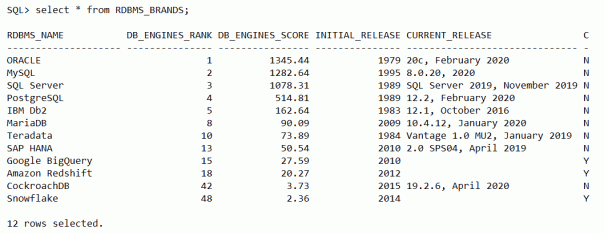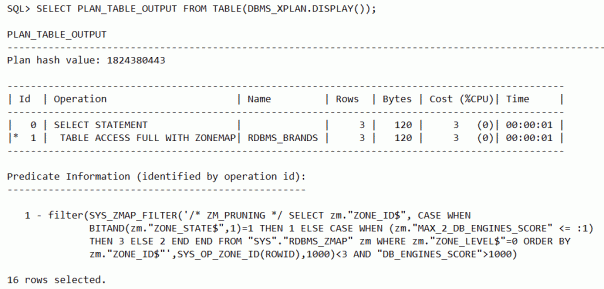In Oracle 20c, the init.ora parameter DB_SECUREFILE defaults to PREFERRED. This means that all large objects / LOBs are created as SecureFiles unless BASICFILE is explicitly specified in the LOB storage clause or the tablespace is an MSSM (= Manual Segment Space Management) tablespace.
Until 19c, only defragmentation of BasicFile LOBs was possible. Tim Hall showed, that in order to shrink a SecureFile LOB you need to move it.
SecureFiles defragmentation in 20c provides online defragmentation of allocated and freed space in SecureFiles segments for all types of SecureFiles LOBs – compressed, deduplicated and encrypted.
In an Oracle 20.2.0 database, I have a table called BLOGS. Let us turn on compression, deduplication and encryption:
SQL> ALTER TABLE blogs MODIFY LOB (blog_text) (COMPRESS HIGH ENCRYPT DEDUPLICATE); Table altered.
Defragmentation can be done automatically by a background process and the segment advisor can estimate the fragmentation levels and how much space can be saved. Note that some temp segment space needed to hold intermediate results.
Let us try to defragment the SecureFiles LOB column BLOG_TEXT and use the segment space advisor to see what is forecast vs. reallity.
In order to defragment the SecureFiles LOBs, we need to use the shrink_clause. The shrink_clause lets us (in general) manually shrink space in a table, index-organized table or its overflow segment, index, partition, subpartition, LOB segment, materialized view, or materialized view log. This clause is valid only for segments in tablespaces with automatic segment management.
By default, Oracle Database compacts the segment, adjusts the high water mark, and releases the recuperated space immediately. Compacting the segment requires row movement. Therefore, you must enable row movement for the object you want to shrink before specifying this clause. Further, if your application has any rowid-based triggers, you should disable them before issuing this clause.
SQL> ALTER TABLE blogs ENABLE ROW MOVEMENT; Table altered.
With release 20c, you can use the shrink_clause on SecureFile LOB segments by using these two ways in order to invoke it:
1. Target a specific LOB column and all its partitions:
ALTER TABLE blogs MODIFY LOB (blog_text) (SHRINK SPACE);
2. Cascade the shrink operation for all the LOB columns of the table and its partitions:
ALTER TABLE blogs SHRINK SPACE CASCADE;
Do not attempt to enable row movement for an index-organized table before specifying the shrink_clause. The ROWID of an index-organized table is its primary key, which never changes. Therefore, row movement is neither relevant nor valid for IOTs.
There are 2 important options/keywords with the shrink space syntax:
COMPACT: If you specify COMPACT, then Oracle only defragments the segment space and compacts the table rows for subsequent release. Meaning Oracle will recover space but will not amend the high water mark (HWM). So, Oracle does not release the space immediately.
CASCADE: If you specify CASCADE, then Oracle performs the same operations on all dependent objects of table, including secondary indexes on index-organized tables. Meaning Oracle will recover space for the object and all dependent objects.
Lat us follow the steps for the BLOGS table:
1. Run the Segment Space Advisor:
DECLARE
seg_task_id number;
seg_task_name varchar2(100);
seg_task_desc varchar2(500);
BEGIN
seg_task_name := 'SecureFileDefragmentation1';
seg_task_desc := 'Manual Segment Advisor Run for table BLOGS';
dbms_advisor.create_task (
advisor_name := 'Segment Advisor',
task_id := seg_task_id,
task_name := seg_task_name,
task_desc := seg_task_desc);
END;
/
DECLARE
obj_id number;
BEGIN
dbms_advisor.create_object (
task_name := 'SecureFileDefragmentation1',
object_type := 'TABLE',
attr1 := 'JULIAN',
attr2 := 'BLOGS',
attr3 := NULL,
attr4 := NULL,
attr5 := NULL,
object_id := obj_id);
END;
/
BEGIN
dbms_advisor.set_task_parameter(
task_name := 'SecureFileDefragmentation1',
parameter := 'recommend_all',
value := 'TRUE');
END;
/
exec dbms_advisor.execute_task('SecureFileDefragmentation1');
2. Let us check the findings from DBA_ADVISOR_FINDINGS:
SQL> select message,more_info from dba_advisor_findings where task_name='SecureFileDefragmentation1'; MESSAGE ------- MORE_INFO ----------------------------------------------------------------------- The free space in the object is less than 10MB. Allocated Space:15728640: Used Space:4013928: Reclaimable Space :180376:
3. Now let us defragment the SecureFile LOB:
SQL> select bytes from dba_segments where segment_name='BLOGS';
BYTES
----------
15728640
SQL> ALTER TABLE blogs MODIFY LOB (blog_text) (SHRINK SPACE);
Table altered.
SQL> select bytes from dba_segments where segment_name='BLOGS';
BYTES
----------
14745600
SQL> ALTER TABLE blogs SHRINK SPACE CASCADE;
Table altered.
SQL> select bytes from dba_segments where segment_name='BLOGS';
BYTES
----------
1048576
As you can see, with the simple operations above, we managed to decrease the size of the BLOGs table 15 times: from 15728640 to 1048576 bytes.
The shrink_clause is subject to the following restrictions:
– You cannot combine this clause with any other clauses in the same ALTER TABLE statement.
– You cannot specify this clause for a cluster, a clustered table, or any object with a LONG column
– Segment shrink is not supported for tables with function-based indexes, domain indexes, or bitmap join indexes
– With this clause, Oracle does not shrink mapping tables of index-organized tables, even if you specify CASCADE
– You can specify the shrink_clause for a table with advanced row compression enabled (ROW STORE COMPRESS ADVANCED) but you cannot specify this clause for a table with any other type of table compression enabled
– You cannot shrink a table that is the master table of an ON COMMIT materialized view
– Rowid materialized views must be rebuilt after the shrink operation.










